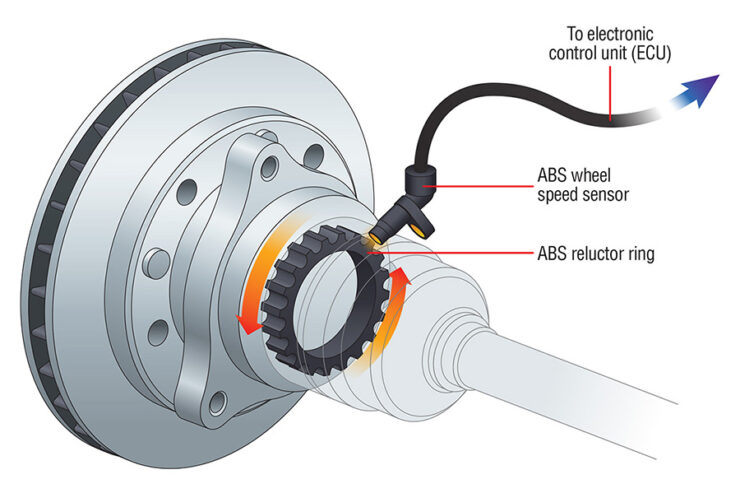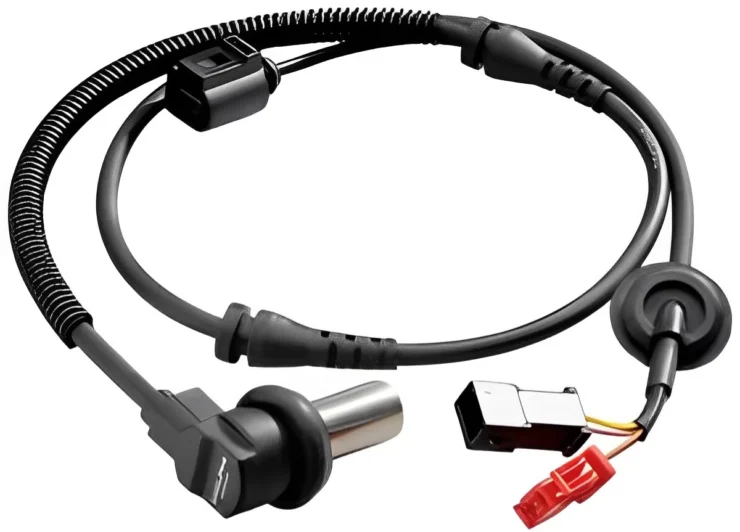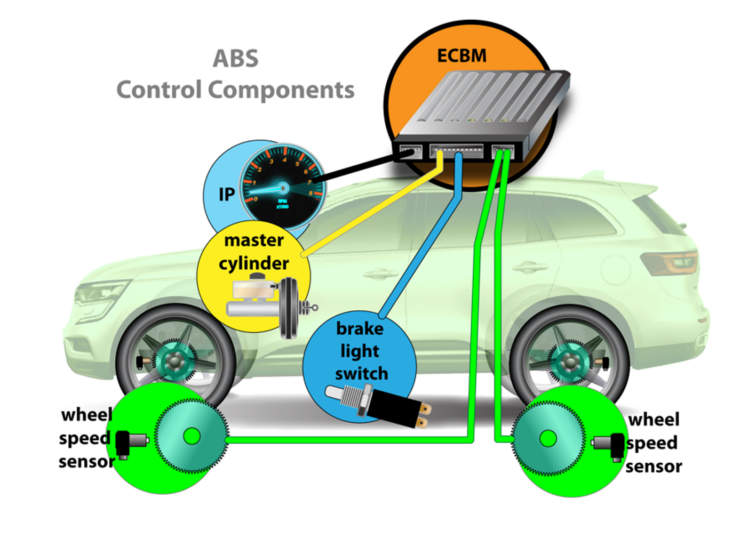The automotive industry has witnessed significant advancements in technology over the years, leading to improved safety and performance features in vehicles. One such crucial component is the Speed Sensor ABS (Anti-lock Braking System). In this article, we will delve into the 14 must-know facts about Speed Sensor ABS, exploring how it enhances vehicle safety and performance.
1. Understanding the Speed Sensor ABS
The Speed Sensor ABS is a vital part of a vehicle’s braking system. It monitors the rotational speed of each wheel and helps prevent the wheels from locking up during sudden braking or when driving on slippery surfaces. By detecting wheel speed, the Speed Sensor ABS enables the Anti-Lock Braking System to modulate brake pressure, ensuring maximum traction and steering control.
2. How Speed Sensor ABS Works
The Speed Sensor ABS works by utilizing a magnet and a coil to generate an electric signal. As the wheel rotates, the magnetic field changes, inducing a voltage in the coil, check here actual Sensor part. This voltage signal is then sent to the ABS control unit, which interprets the data and determines if wheel lock-up is imminent. If necessary, the ABS control unit adjusts brake pressure through a hydraulic modulator, allowing the wheel to continue rotating.
3. Importance of Speed Sensor ABS for Vehicle Safety
The primary purpose of the Speed Sensor ABS is to enhance vehicle safety. By preventing wheel lock-up, it ensures that the driver maintains steering control even during emergency braking situations. This significantly reduces the risk of accidents and allows the driver to maneuver the vehicle safely. Contact a reputable car accident law firm, like The Levin Firm, should you ever be unfortunate enough to be involved in a car accident.
4. Benefits of Speed Sensor ABS on Different Road Conditions

The Speed Sensor ABS is particularly effective on various road conditions. Whether driving on wet, icy, or uneven surfaces, the system ensures that the wheels do not lock up, providing optimal traction. This feature is especially valuable in regions with harsh weather conditions, as it improves the vehicle’s stability and reduces the chances of skidding.
5. Compatibility with Electronic Stability Control (ESC)
Speed Sensor ABS is often integrated with Electronic Stability Control (ESC) systems. ESC further enhances vehicle safety by actively monitoring and controlling the vehicle’s stability. By working together, ABS and ESC offer a comprehensive safety package, minimizing the risk of accidents caused by loss of control or instability.
6. Regular Maintenance and Troubleshooting
Like any other automotive component, the Speed Sensor ABS requires regular maintenance and occasional troubleshooting. It is essential to keep the sensors clean and inspect them for any damage or wear. Faulty speed sensors can result in ABS malfunctions, leading to compromised safety. Consulting a professional mechanic for maintenance and repairs is highly recommended.
7. Diagnostic Tools for Speed Sensor ABS

Modern vehicles are equipped with onboard diagnostic systems that can detect and report ABS-related issues. These systems can pinpoint specific problems with the Speed Sensor ABS, making it easier for technicians to diagnose and resolve any malfunctions. Using diagnostic tools ensures accurate troubleshooting and timely repairs, keeping the ABS system in optimal condition.
8. The Role of Speed Sensor ABS in Vehicle Performance
While the primary focus of the Speed Sensor ABS is safety, it also plays a crucial role in overall vehicle performance. By maintaining traction and stability during braking, the ABS system allows for shorter stopping distances. This feature is particularly beneficial in high-performance vehicles where precise control and quick deceleration are essential.
9. Limitations and Considerations
Despite its numerous advantages, the Speed Sensor ABS does have limitations. It is important to note that ABS cannot compensate for inadequate tire grip or reckless driving. It is still crucial for drivers to maintain safe speeds and follow appropriate braking techniques. Additionally, the ABS system may not be as effective on loose surfaces like gravel or sand, where wheel lock-up is less likely to occur.
10. Integration with Advanced Driver Assistance Systems (ADAS)
With the advancement of technology, Speed Sensor ABS is now integrated with Advanced Driver Assistance Systems (ADAS). This integration allows the ABS system to work in conjunction with features such as adaptive cruise control, collision warning systems, and lane-keeping assist. By sharing information and collaborating with other safety systems, Speed Sensor ABS enhances overall vehicle safety and assists in accident prevention.
11. Maintenance Considerations for Speed Sensor

ABS Proper maintenance of the Speed Sensor ABS is essential for optimal performance. It is crucial to regularly inspect the sensor’s wiring and connections for any signs of damage or corrosion. Additionally, ensuring the correct air gap between the sensor and the wheel is crucial for accurate speed detection. Routine maintenance, as per the manufacturer’s recommendations, helps to prolong the lifespan of the Speed Sensor ABS and maintain its reliability.
12. Importance of Speed Sensor ABS Calibration
After any repair or replacement of ABS components, including the Speed Sensor ABS, calibration is necessary. Calibration ensures that the ABS system functions accurately and provides reliable data. Improper calibration can lead to incorrect readings and potential system malfunctions. It is recommended to have the calibration performed by a professional technician with the appropriate tools and expertise.
13. Integration with Brake-by-Wire Systems
As automotive technology continues to advance, the integration of Speed Sensor ABS with Brake-by-Wire (BBW) systems is becoming more prevalent. BBW systems replace traditional hydraulic brake systems with electronic controls, offering enhanced precision and responsiveness. By working in conjunction with Speed Sensor ABS, BBW systems can provide finer control over brake pressure, resulting in improved safety and performance.
14. Speed Sensor ABS in Electric and Hybrid Vehicles

Speed Sensor ABS plays a crucial role in electric and hybrid vehicles, where regenerative braking systems are used. Regenerative braking harnesses the kinetic energy produced during braking and converts it into electrical energy, which is then stored in the vehicle’s battery. The Speed Sensor ABS helps in seamlessly transitioning between regenerative and mechanical braking, ensuring a smooth and efficient braking experience.
Conclusion
The Speed Sensor ABS is an integral component of modern vehicle safety systems. By preventing wheel lock-up and enhancing traction, it significantly improves vehicle safety and performance. Understanding the key facts about Speed Sensor ABS, its maintenance requirements, and its integration with other advanced systems allows drivers and technicians to make the most of this essential safety feature. With ongoing advancements in automotive technology, Speed Sensor ABS is expected to continue evolving, further enhancing vehicle safety in the future.
Related Posts:
- What Does STI Stand for Subaru? A Journey of Speed…
- Best Toyota Car, Truck & SUV Information 2024 -…
- 13 Best Brake Pads For Toyota Corolla 2024 - Ensure…
- 10 Best Bull Bar for Tacoma 2024 - Increase Your…
- How to Reset Throttle Position Sensor in Toyota -…
- How To Reset Oxygen Sensor of Car/Truck in 2024 -…













